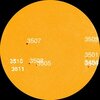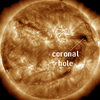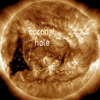SOLAR CYCLE ACTIVITY REPORT DECEMBER 04_2023
There are currently 8 sunspot regions on the solar disk: AR3500, AR3501, AR3505, AR3507 AR3508, AR3509 and new regions AR3510
AR3511

AR3494 & AR3503 are gone
● Auroral Activity

● Current Conditions at 05:00 UTC on December 04
▪︎ Geospace quiet (Kp 2)
▪Solar wind speed record: 510.3 km/sec (Moderately high speed)
▪︎ density: 16.5 p/cm³ (Moderate density)
▪︎ Interplanetary Magnetic Field (IMF)
Bt: 8.11 nT
▪︎ Thermosphere Climate Index
today: 19.10x1010 W Warm
▪︎ Neutron Counts today: - 6.9 % (Low)
▪︎ X-ray Solar Flare: C8 0126 UT Dec04
▪︎ Sunspot number: 107 (SN 92 December 03)
▪︎ Spotless Days 2023 total: 0 days (0%)
▪︎ Solar wind flowing from a large coronal hole should reach Earth on Dec. 4-5.

SpaceWeatherlive.com
SpaceWeather.com
Solar activity has been at low levels for the past 24 hours. The largest solar event of the period was a C4 event observed at 08:06 UTC from Region 3494 (S17W96).
There are currently 8 sunspot regions on the solar disk: AR3500, AR3501, AR3505, AR3507 AR3508, AR3509 and new regions AR3510
AR3511
AR3494 & AR3503 are gone
Total number of sunspots has increased to 107 (27 of these are grouped into 8 active regions) NOAA forecasts for the next 24h: 99% chance for C flares, 30% chance M flares and 5% chance for X flares. Sunspot region AR3500 has a beta-gamma magnetic field that harbors energy for M-class flares but it will be leaving the solar disk in the next few hours. All other regions have stable magnetic fields.
● Auroral Activity
The geomagnetic field has been at quiet to unsettled levels for the past 24 hours. On December 3 Solar wind speed reached a peak of 502 km/s (Moderately high speed) at 20:56 UTC. Total IMF reached 10 nT at 21:08 UTC
Aurora Oval Bz: -0.48 nT SouthGEOMAGNETIC STORM WATCH (G2): Earth's magnetic field is about to receive a double blow. First, on Dec. 4th, a high-speed stream of solar wind flowing from a coronal hole will arrive. Then, on Dec. 5th, an off-target CME could deliver a glancing blow. Their combined effect is expected to cause G1 (Minor) to G2-class (Moderate) geomagnetic storms with photographic auroras at mid-latitudes. SpaceWeather.com
● Current Conditions at 05:00 UTC on December 04
▪︎ Geospace quiet (Kp 2)
▪Solar wind speed record: 510.3 km/sec (Moderately high speed)
▪︎ density: 16.5 p/cm³ (Moderate density)
▪︎ Interplanetary Magnetic Field (IMF)
Bt: 8.11 nT
▪︎ Thermosphere Climate Index
today: 19.10x1010 W Warm
▪︎ Neutron Counts today: - 6.9 % (Low)
▪︎ X-ray Solar Flare: C8 0126 UT Dec04
▪︎ Sunspot number: 107 (SN 92 December 03)
▪︎ Spotless Days 2023 total: 0 days (0%)
▪︎ Solar wind flowing from a large coronal hole should reach Earth on Dec. 4-5.
A HOLE IN SUN'S ATMOSPHERE: A huge hole has opened in the sun's atmosphere, and it spewing a stream of solar wind directly toward Earth. NASA's Solar Dynamics Observatory photographed the structure, which stretches almost 800,00 km along its long axis:

This is a coronal hole--a region in the sun's atmosphere where magnetic fields have opened up, allowing solar wind to escape. The hole looks dark because hot glowing gas normally contained there is missing. The gaseous material is on its way to Earth.
........
SpaceWeatherlive.com
SpaceWeather.com








